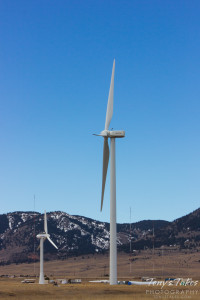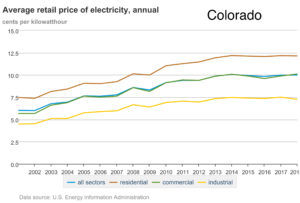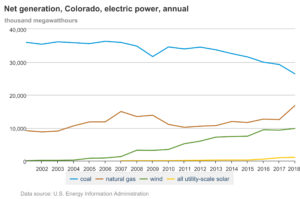Physics of energy generation makes Polis’ 100 percent renewables goal unlikely
In a June 25 article, Bloomberg reporter Chris Martin wrote, “Hydroelectric dams, solar panels and wind turbines generated almost 68.5 million megawatt-hours of power in April, eclipsing the 60 million that coal produced that month.” Martin goes on to say, “The two forms of power have become so cheap to build that BloombergNEF is projecting that half the world’s power may come from renewable energy by 2050.”
The problem is that the only way the EIA and Bloomberg reached the conclusion that renewables outstripped coal was by including hydropower generation in the calculation, something that doesn’t really fit in with the “two forms of power” Martin claims are so cheap to build. Hydroelectric dams are neither cheap nor easy to build, and in fact the number of power-generating dams has been decreasing, especially in the Pacific Northwest where many older dams have been decommissioned and removed to restore habitat where salmon and steelhead trout spawn.
Industry experts point out that the physics of electrical generation are unlikely to allow wind and solar to supply a majority of our power, much less Governor Polis’ goal of achieving 100% renewables in Colorado.
Complete Colorado interviewed Charles Griffey, an electric utility resource planning consultant and former senior officer at Reliant Energy, a Texas provider with more than 2 million customers, who said reaching 100% renewable energy “Can’t be done with existing technology.”
“Renewables don’t provide the capability to meet the second to second movements in the electric system,” said Griffey. “You can’t maintain electrical reliability, you have to have electrical capacity that moves up and down quickly.”
IT’S A MATTER OF PHYSICS–

America operates on 60 cycles per second, or 60 Hz. That grid frequency can vary only about 2 Hz in either direction, says Griffey. “These are small variations, but if it drops below that you start kicking off loads,” he said. “Bad things happen and your system crashes.”
The grid is so sensitive to these variations that power producers must provide both reserve capacity to deal with sudden load increases and “grid inertia” to keep the frequency stable.
“You have to have inertia on the system that helps buffer load changes, and inertia is provided by turbines that spin. Renewables don’t have inertia,” said Griffey.
Without the electrical inertia available from fuel-powered, constantly-spinning generators, the entire grid can crash unexpectedly if the wind stops blowing while the sun isn’t shining.
This means that renewables like wind and solar will always require backup generators to provide both inertia and reliable power to take up unexpected loads.
And how much backup is required increases with the amount of renewables in the system.
“The more intermittent capacity you have, or the more unreliable capacity you have, you actually have to increase that reserve margin to carry more backup,” Griffey said.
“In the case of an all-wind system you’re going to be carrying 90 percent, give or take, to back it up because [windmills] only provide 5 to 15% of equivalent capacity,” said Griffey.
By equivalent capacity Griffey means that the advertised theoretical capacity of a wind farm of say 30 megawatts, called the “nameplate capacity,” only ever actually produces a fraction of that amount, called the “efficiency factor.”
Other sources place the efficiency factor of wind generators between 25% and 40%.
The efficiency of a wind farm of course varies from minute to minute depending on wind speed. Too little wind and they stop turning, too much wind and they have to be shut down to prevent destructive over-speeding that can rip a windmill to pieces.
“In terms of setting reserve margins, you can’t count on non-firm energy availability under the standards that are in place across the United States, you have to have firm deliverable power,” said Griffey.
This is also called “base load capacity,” which means constant-power sources that can deliver the usual amount of electricity the grid needs. There are three kinds of reliable base load sources: Fossil fuel, hydroelectric and nuclear generators.
Fossil fuel-driven sources provide the vast majority of base load capacity not just in the U.S., but worldwide.
XCEL’S COLORADO ENERGY PLAN RUNS IN TO REALITY–
Xcel Energy was recently given permission by the Colorado Public Utilities Commission (CPUC) to shut down two of the three coal-fired generating units at the Comanche Generation Station outside of Pueblo that provide a substantial portion of Xcel’s base load and backup capacity and replace them with windmills, solar panels and what would be the largest battery storage system in the U.S.

Xcel persuaded the CPUC that prematurely retiring the Comanche plant was a good idea because of extremely low bids submitted by contractors to provide renewable power.
“We note that the wind bids are exceptionally low as compared to the pricing information provided in Public Service’s previous wind resource proceedings,” said the CPUC. “[Xcel] can take advantage of exceptional prices for new resources without risking that such cost-competitive resource alternatives are unavailable in another ten years.”
But Xcel’s Colorado Energy Plan (CEP) is already falling apart.
Some contractors recently told Xcel that they were withdrawing their bids because they could not afford to fulfill them.
Putting the cart before the horse, Xcel solicited bids and then touted them to the CPUC without first determining if they were realistic.
“[Xcel] takes these indicative bids and tries to complete an actual contract,” said Griffey. “Quite frequently, as it appears in Colorado, the renewable contractors are coming in at a higher price than what was in the bids that lead to the decisions to retire the coal plant.”

“Renewables are absolutely not cheaper. I think that was pretty well demonstrated in the decision that the commission made to go forward with the Colorado Energy Plan,” said Griffey. “They are in essence relying on the extra 2% that goes towards more expensive renewables to help pay for this plan. That’s an admission in and of itself that it’s not cheaper.”
“Xcel cut the deal with the renewable groups and then got it approved, but it only works with the extra revenue,” Griffey continued. “If this deal wasn’t approved Xcel would have to pay the extra costs, so it’s clearly more expensive. It comes out of customer’s bills.”
But even if Xcel can provide the promised renewable energy, the claim that it’s moving towards Polis’ goal of “100 percent renewables by 2050” is dubious at best, given the physics of electrical generation and grid operation.

No comments:
Post a Comment